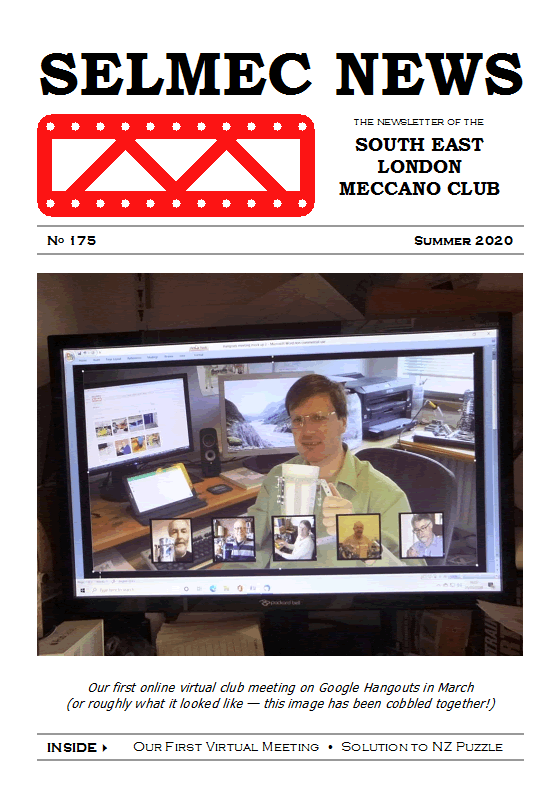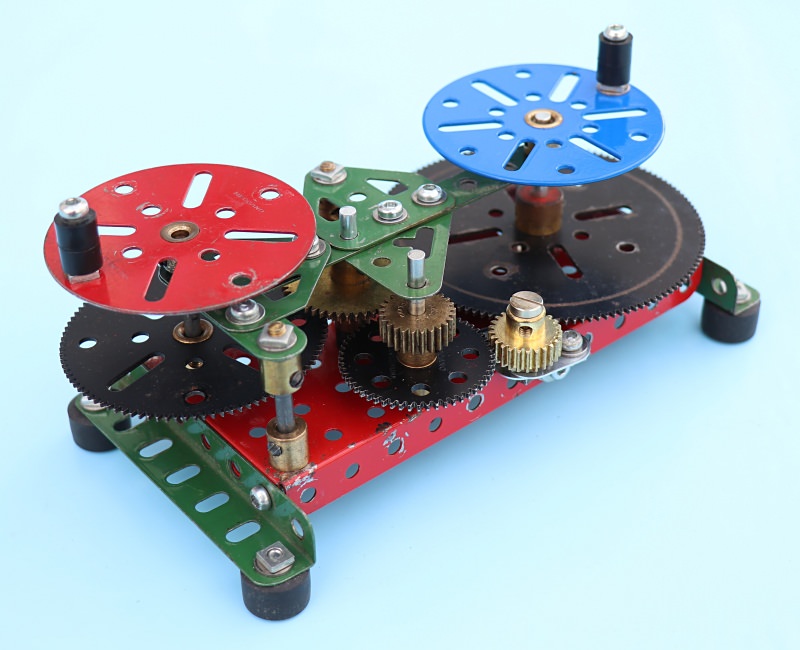Summer 2020 Newsletter

Summer 2020 Newsletter
Issue 175
Due to the coronavirus pandemic this meeting was cancelled and was held ‘virtually’ online via Google Hangouts.
At around 2:00pm we had our annual general meeting, followed by the Model Tour in which members were invited to give a short talk about their models — in particular their entries for the Secretary’s Challenge!
Written by Alan Wenbourne
A puzzle was posed in the November 2019 issue (Vol. 43, № 4) of the New Zealand Federation of Meccano Modellers Magazine as follows:
To describe a spur gear train using metal Meccano factory gears that will produce an output of 3.14 turns for an input of one revolution. Minimum acceptable level of precision is two decimal places.
It was assumed that what was meant by ‘Meccano factory gears’ are those produced by Binns Road, Calais and Exacto, including clockwork motor gears.
Thus, the tooth count of legitimate gears is:
11, 12, 13, 15, 19, 20, 22, 25, 30, 38, 45, 50, 55, 56, 57, 60, 95 and 133.
For ratio analysis, all combinations of meshing pairs were computed as shown in the table below.
Gear ratios: 3/A (column value divided by row value)
| № Teeth |
11 |
12 |
13 |
15 |
19 |
20 |
22 |
25 |
30 |
| 11 |
1 |
1.091 |
1.182 |
1.364 |
1.727 |
1.818 |
2 |
2.273 |
2.727 |
| 12 |
0.917 |
1 |
1.083 |
1.25 |
1.583 |
1.667 |
1.833 |
2.083 |
2.5 |
| 13 |
0.846 |
0.923 |
1 |
1.154 |
1.462 |
1.538 |
1.692 |
1.923 |
2.308 |
| 15 |
0.733 |
0.8 |
0.867 |
1 |
1.267 |
1.333 |
1.467 |
1.667 |
2 |
| 19 |
0.579 |
0.632 |
0.684 |
0.789 |
1 |
1.053 |
1.158 |
1.316 |
1.579 |
| 20 |
0.55 |
0.6 |
0.65 |
0.75 |
0.95 |
1 |
1.1 |
1.25 |
1.5 |
| 22 |
0.5 |
0.545 |
0.591 |
0.682 |
0.864 |
0.909 |
1 |
1.136 |
1.364 |
| 25 |
0.44 |
0.48 |
0.52 |
0.6 |
0.76 |
0.8 |
0.88 |
1 |
1.2 |
| 30 |
0.367 |
0.4 |
0.433 |
0.5 |
0.633 |
0.667 |
0.733 |
0.833 |
1 |
| 38 |
0.289 |
0.316 |
0.342 |
0.395 |
0.5 |
0.526 |
0.579 |
0.658 |
0.789 |
| 45 |
0.244 |
0.267 |
0.289 |
0.333 |
0.422 |
0.444 |
0.489 |
0.556 |
0.667 |
| 50 |
0.22 |
0.24 |
0.26 |
0.3 |
0.38 |
0.4 |
0.44 |
0.5 |
0.6 |
| 55 |
0.2 |
0.218 |
0.236 |
0.273 |
0.345 |
0.364 |
0.4 |
0.455 |
0.545 |
| 56 |
0.196 |
0.214 |
0.232 |
0.268 |
0.339 |
0.357 |
0.393 |
0.446 |
0.536 |
| 57 |
0.193 |
0.211 |
0.228 |
0.263 |
0.333 |
0.351 |
0.386 |
0.439 |
0.526 |
| 60 |
0.183 |
0.2 |
0.217 |
0.25 |
0.317 |
0.333 |
0.367 |
0.417 |
0.5 |
| 95 |
0.116 |
0.126 |
0.137 |
0.158 |
0.2 |
0.211 |
0.232 |
0.263 |
0.316 |
| 133 |
0.083 |
0.09 |
0.098 |
0.113 |
0.143 |
0.15 |
0.165 |
0.188 |
0.226 |
| № Teeth |
38 |
45 |
50 |
55 |
56 |
57 |
60 |
95 |
133 |
| 11 |
3.455 |
4.091 |
4.545 |
5 |
5.091 |
5.182 |
5.455 |
8.636 |
12.091 |
| 12 |
3.167 |
3.75 |
4.167 |
4.583 |
4.667 |
4.75 |
5 |
7.917 |
11.083 |
| 13 |
2.923 |
3.462 |
3.846 |
4.231 |
4.308 |
4.385 |
4.615 |
7.308 |
10.231 |
| 15 |
2.533 |
3 |
3.333 |
3.667 |
3.733 |
3.8 |
4 |
6.333 |
8.867 |
| 19 |
2 |
2.368 |
2.632 |
2.895 |
2.947 |
3 |
3.158 |
5 |
7 |
| 20 |
1.9 |
2.25 |
2.5 |
2.75 |
2.8 |
2.85 |
3 |
4.75 |
6.65 |
| 22 |
1.727 |
2.045 |
2.273 |
2.5 |
2.545 |
2.591 |
2.727 |
4.318 |
6.045 |
| 25 |
1.52 |
1.8 |
2 |
2.2 |
2.24 |
2.28 |
2.4 |
3.8 |
5.32 |
| 30 |
1.267 |
1.5 |
1.667 |
1.833 |
1.867 |
1.9 |
2 |
3.167 |
4.433 |
| 38 |
1 |
1.184 |
1.316 |
1.447 |
1.474 |
1.5 |
1.579 |
2.5 |
3.5 |
| 45 |
0.844 |
1 |
1.111 |
1.222 |
1.244 |
1.267 |
1.333 |
2.111 |
2.956 |
| 50 |
0.76 |
0.9 |
1 |
1.1 |
1.12 |
1.14 |
1.2 |
1.9 |
2.66 |
| 55 |
0.691 |
0.818 |
0.909 |
1 |
1.018 |
1.036 |
1.091 |
1.727 |
2.418 |
| 56 |
0.679 |
0.804 |
0.893 |
0.982 |
1 |
1.018 |
1.071 |
1.696 |
2.375 |
| 57 |
0.667 |
0.789 |
0.877 |
0.965 |
0.982 |
1 |
1.053 |
1.667 |
2.333 |
| 60 |
0.633 |
0.75 |
0.833 |
0.917 |
0.933 |
0.95 |
1 |
1.583 |
2.217 |
| 95 |
0.4 |
0.474 |
0.526 |
0.579 |
0.589 |
0.6 |
0.632 |
1 |
1.4 |
| 133 |
0.286 |
0.338 |
0.376 |
0.414 |
0.421 |
0.429 |
0.451 |
0.714 |
1 |
The pair of gears returning the nearest ratio to the puzzle requirement is:
60/19 = 3.157894737
The simplest improper fraction representing π is: 22/7 (31/7), this equals 3.14 decimal. A direct meshing pair (22/7) is not possible because there is not a 7-tooth pinion in the system. However, the meshing pair 133/19 = 7 provides the denominator value.
Considering the numerator value of 22, or its reciprocal, i.e. 1/22 = 0.0454545…, from the table, meshing 25/55 gives 0.454545…, but this needs to be factored by 0.1. Again, from the table, 11/55 = 0.2 and 11/55 = 0.2 were selected, the product of which yields 0.1.
Thus, substituting 22/7 for 55/25 x 55/11 x 22/11 x 19/133 = 3.142857143 — Eurika!
This train was modelled to prove its feasibility, especially as most of the operating centre distances were not modules of ½”! The problem with this arrangement was that the input could not be driven, due to the high overdrive ratio and inherent friction. If possible, eliminating the 11-tooth pinions would overcome the friction issue and avoid the dubious use of clockwork motor gears.
Much thought and interrogation of the chart and poring over Brocot tables did not help until I hit on the idea of considering the reciprocal of 22/7 i.e. 7/22 = 0.3181818… Then, by introducing the 95- and 50-tooth gears, the combination 133/55 x 25/50 x 25/95 = 0.3181818… came to light! — Eureka (2).

Alan’s solution to the puzzle
In the model shown, the red Face Plate is input and the blue the output. The addition of an 25-tooth pinion between the 133-tooth and 55-tooth gears avoids the two thin gears meshing together and enables the output rotation to be the same as input.
The pivot bolts on the Face Plates are used to align the input and output shafts in known relationship for counting revolutions. The output shaft group has vertical freedom in order to disengage the 133-tooth Gear for re-establishing the relationship.
As it is difficult to visualize 1/7 of a revolution in testing the principle, if the output is rotated 22 times, the input can be seen to make 7 revolutions.